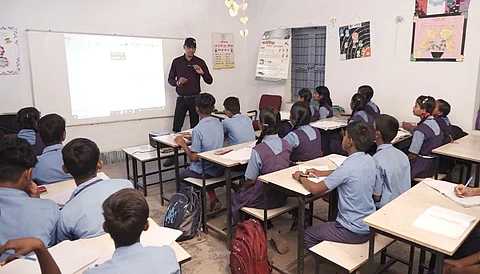
- News Updates
- PSU Watch
- Defence News
- Policy Watch
- हिन्दी न्यूज़
- Jobs Watch
- States News
- Event News

New Delhi: Jhabar village is located a few kilometers away from SECL's Dipka Mega Project. Gaurav Singh, studying in Class VIII of the Government Pre-Secondary School here, is excited to talk about smart-class installed at his school. There are many such villages around his village Jhabar where for the first time, modern techniques of teaching and learning like smart classes have been installed in government schools. He says, “School mein hamla projector le padhaye jathe au smart-class lage le more padhaani ma ab bahut mann lagta hai. Ekar se padhe maa bahut maza aavat he, jekar se hamla roz school aaye ke man karthey.” (We are taught using projectors in our school and since the installation of smart class I am more interested in my studies. Learning in smart-class is fun and I love going to school everyday).
What is Smart Class?
Traditionally, children in schools have been taught by teachers through the blackboard by verbally explaining things. When education is imparted through electronic devices in the class, then it is called a smart-class or digital classroom. In such a class, instead of black-board or white-board, digital board or interactive board is used. It is connected to the computer with the help of cable and along with this a projector is connected to the computer with the help of VGA cable. A classroom where teaching and learning is done with the help of these electronic devices is called a smart-class.
696 smart classes have been made by SECL in schools of Korba and Raigad districts
Sensing the possibilities of development of educational infrastructure in government schools of Koyalanchal, SECL planned to introduce smart classes in these schools through CSR. Under this, smart classes have been set-up in 500 government schools of Korba district by the company at a cost of about Rs 9 crore through the District Collector Korba. In this mainly projector-based teaching techniques has been adopted.
On the other hand, 113 smart classes have been developed at a cost of Rs 4.68 crore through the district administration Raigarh in government schools built within 25 km radius of SECL office in Raigarh district. Along with this, 83 interactive boards/smart-class facilities have been developed in schools in Raigarh, Dharamjaigarh, and Kharsia tehsils of Raigarh district at a cost of Rs 2.75 crore.
Smart classes are allowing children to enjoy studying, they are becoming more eager to learn
With the formation of smart-classes, the children of tribal areas studying in government schools are also getting education through modern teaching methods. Due to this, children are becoming more confident and they are more eager to read and learn something new. Speaking in English, Gaurav Dadsena, studying in class 11th at Government Natwar English School, Raigarh, says that the teachers at our school teach us and clear our doubts related to various subjects through smart-classes. He says that with the introduction of smart classes, a different learning environment has been created in the school.
In recent years, several steps are being taken in the state of Chhattisgarh to increase the Gross Enrolment Ratio of children from classes I to VIII. According to the Government of India's Economic Survey 2022-23 report, in the year 21-22, the gross enrolment ratio of children from class one to eighth in the state of Chhattisgarh has been around 96 percent. Initiatives like smart-classes in government schools are making a significant contribution in this direction and are awakening a new interest in children towards studies.
Disclaimer: This story is a press release and is being published without any editing by the PSU Watch desk.
(PSU Watch– India's Business News centre that places the spotlight on PSUs, Bureaucracy, Defence and Public Policy is now on Google News. Click here to follow. Also, join PSU Watch Channel in your Telegram. You may also follow us on Twitter here and stay updated.)
